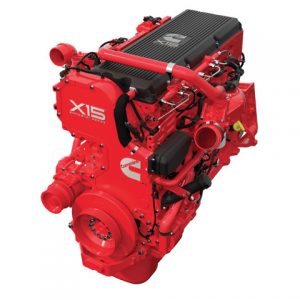Diesel engines could finally get cylinder deactivation tech, thanks to Cummins and Tula partnership
Flying in the face of the current electrified trend, Cummins has announced a partnership with Tula Technology to develop a cylinder deactivation system for heavy-duty diesel engines, like those found in big rigs and other large commercial machines. Tula brought its skip-fire technology to Cummins’ X15 commercial diesel engine with Diesel Dynamic Skip Fire (dDSF), utilizing a mechanism very similar to the Displacement on Demand (DOD) tech found in General Motors’ V-8s. However, while GM uses its DOD system to enhance the fuel economy of its consumer products, Cummins and Tula are primarily pursuing skip-fire tech because of its potential to lower emissions.
Advances in diesel combustion technology is particularly vital to the over-the-road (OTR) trucking industry. Lugging trailers across the North American continent presents incredible challenges for electric drivelines; vast range and minimal refueling are imperative when scheduling bulk shipments of freight. While some promising battery chemistries do improve power density compared to current lithium-based batteries packs, they haven’t yet trumped the usable energy of a gallon of fuel.
For now, then, it’s most worthwhile to manufacturers to invest most of their cash in diesel technology. This is where dDSF becomes an interesting pitch; it seeks to solve one of the main weak points in diesel emissions controls.
The problem with current diesels
Diesel engines achieve relatively high fuel economy over their gasoline-powered counterparts because of their higher compression ratios. In the first place, diesel engines require higher compression ratios simply to burn the fuel; diesel’s hydrocarbon molecule chains are less volatile than gasoline and thus require more heat to ignite. In addition, a significant advantage of diesel fuel is that it contains more caloric energy by volume than gasoline. For the same gallon of fuel, diesel has approximately 15 percent more energy over gasoline, according to the European Automobile Manufacturers Association.
That higher compression ratio burns the diesel more thoroughly, as well, due to increased combustion chamber temperatures and pressures induced by the tighter squishing of the fuel/air charge. Combined with the lean-burning nature of diesel engines—which are throttled primarily by limiting fuel, and not air—diesel engines have traditionally offered incredible fuel economy for their outputs.
The trade-off with increased compression ratios, however, is high emissions. Though they tend to produce lower hydrocarbon emissions (from unburnt fuel) than gas engines, diesel engines suffer from high nitrogen oxide (NOx) emissions. (NOx emission is, in part, what bit Volkswagen hard during 2015’s “Dieselgate;” their EPA-cheating control algorithms reduced NOx output in laboratory testing while pumping out significantly more under typical driving conditions.) Like gasoline engines, diesel engines produce the worst pollution when the engine runs below operating temperatures—for instance, in a cold start or under light loads. In either of these scenarios, average combustion temps are lower because the engine is burning less fuel.
Additionally, current emissions controls for particulate emissions (aka soot) require expensive and inconvenient diesel particulate filter (DPF) systems that trap soot created during the normal combustion process. These systems inject a diesel exhaust fluid (DEF) that consists of urea and water into the exhaust steam to break down NOx into less-harmful nitrogen and water during a controlled burn phase. DPF systems are necessary because the alternative is to increase combustion temperatures and exhaust gas temperatures (EGT) to completely burn soot—which increases NOx emissions. The downside of DEF system is that they rely on an expensive fluid and slurp a significant amount of diesel fuel in the burnout process, which can require a truck to be sidelined while the system runs its course. Worse, if the vehicle runs out of DEF, the vehicle will eventually refuse to start—thanks to a programmed emissions safeguard—until the DEF tank is refilled.

The solution from Cummins and Tula
While cylinder deactivation is used in gasoline engines primarily as a fuel economy tool, Cummins and Tula want to solve the emissions challenge. According to a white paper released at the 41st International Vienna Motor Symposium, Cummins/Tula is using dDSF as a method to increase engine operating temperatures quickly while under light loads and during cold starts. The simple theory: By deactivating cylinders, you’re increasing the load on the remaining cylinders, which will require more fuel per injection and produce more heat in the engine block, raising it to an appropriate operating temperature. Additionally, the light load on a typical diesel engine at highway cruising speeds lower exhaust gas temperatures below the threshold necessary to begin the DPF cycle. Deactivating cylinders to increase load—and thus maintain sufficient operating temperature—also increases the exhaust gas temperatures without wasting excessive fuel on longer injection durations.
There are three main variables during the combustion cycle that are relevant to a diesel engine’s ignition timing: start of injection (SOI), end of injection (EOI), and the resulting total injection time (TOT). These variables are counted in degrees of crank rotation, not unlike the spark ignition timing of a gasoline injection engine or the fuel injector timing seen in direct-injection gassers.
Because they are throttled by the total volume of fuel injected during the combustion stroke, diesels can precisely control when they inject fuel into the cylinder. By adjusting the relative start and ending points of injection, they can also control their exhaust gas temperatures. While start of injection (SOI) is treated much like spark advance in a gasser, it’s the end of injection when the magic happens in regards to exhaust gas temperatures (EGT). By injecting fuel later in the combustion stroke, a diesel engine can force the burning fuel into the exhaust system to increase EGTs—the exact conditions dDSF uses to bring catalyst systems up to temp during normal operation.
The trade-off is an increase in fuel consumption during the burn-off of DPF contaminates, but this is largely because half of the cylinders are now powering an 80,000-pound 18-wheeler. The advantage of dDSF technology, though, is the truck can be moving while it works through its DPF cycle; it doesn’t have to stop.
The trucking industry is conservative when it comes to new technology. While EV drivelines promise a wealth of performance, environmental, and efficiency improvements over conventional engines, manufacturers like Cummins must invest in next-generation solutions in order to serve their heavy-duty customers. Fleet managers, meanwhile, maintain their wait-and-see attitudes. Short-route trucks, like the smaller “day cabs” (so named for their one-day-of-work usage, as compared to sleeper cabs driven by long-distance truckers) will quickly benefit from innovations in the EV sector, even with the limitations of current batteries. However, for the nation’s estimated 3.5 million over-the-road (OTR) truckers, who run the interstate routes and may see more than 1000 miles between fuel stops, dDSF technology offers a solution that satiates tightening emissions regulations while serving fleets with a familiar—and potentially more reliable—emissions system than what we see today.


